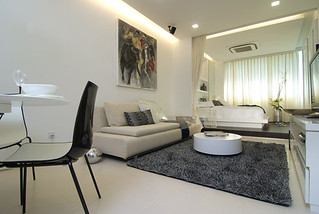Minimalist and Minimalism, Dear Reader, are terms we hear bandied about quite a bit these days. So I thought I’d take a look at minimalism in terms of how it relates to living a simpler life. First let’s look at a brief history of the minimalist movement.
History of Minimalism
 The minimalist movement came into being in the 1950’s as an artistic expression in which a painter or sculptor would employ an extreme economy in his or her work; eliminating all complexity and reducing the work to it’s most basic shape or form. Using very simple shapes and colors to evoke the emotion they desired.
The minimalist movement came into being in the 1950’s as an artistic expression in which a painter or sculptor would employ an extreme economy in his or her work; eliminating all complexity and reducing the work to it’s most basic shape or form. Using very simple shapes and colors to evoke the emotion they desired.
This trend was picked up in the 1970’s by the performing arts when stage productions were done with no sets and only a bare minimum of props; relying on the performers to convey the setting and mood of their location and situation. A bizarre off-shoot of this trend developed when certain producers decided to take it a step further and put on plays that included no costumes – the performers were naked – or nearly so – as well as the stage.
Architecture and interior design embraced minimalism in the late 70’s. The goal was to create a space that was free of complexity and distraction so it would be a soothing retreat from the hubbub of modern life. True minimalist design is quite stark compared to more traditional room design and arrangement. Modern minimalist designs allow more flexibility, focusing on simple shapes, soft colors and a gentle mixture of texture to create a sanctuary from real-world rigors.
What Makes a Room Minimalist
In minimalist designs, selection and location of pieces take on a heightened importance. In a room where only one piece of art work is displayed, the art itself, location and manner of display take on extreme importance. When a single piece or set of furniture is in the space, its design and function will be spotlighted and must be selected to represent the character of its owner. Keywords in Minimalist design are “clean”, “simple” and “uncluttered”.
What Minimalism Is Not
 Today the term ‘minimalist’ is being applied to anything that is simplified or less complex than normal. I just ran across an advertisement for “minimalist running shoes”. That is, no doubt, a term coined by an advertising spin doctor, as they look pretty normal to me. Disposing of clothing you don’t wear to make more room in your closet does not make you a minimalist.
Today the term ‘minimalist’ is being applied to anything that is simplified or less complex than normal. I just ran across an advertisement for “minimalist running shoes”. That is, no doubt, a term coined by an advertising spin doctor, as they look pretty normal to me. Disposing of clothing you don’t wear to make more room in your closet does not make you a minimalist.
Some who pursue simpler lifestyles do embrace minimalist theory simply by reducing the clutter around them to produce a cleaner look. Eliminating some of the “stuff” that you surround yourself with reduces the need to dust 250 knick-knacks and can produce less stress by not worrying about knocking something off every time you walk through the room. Fewer distractions make for a more relaxed atmosphere.
But try telling that to someone whose refrigerator door is covered with hand drawn artwork from their grand children. To them, these are not distractions; they are treasured mementos of their beloved grand kids. What is clutter and what is treasure is something we must each decide for ourselves.
Simplifying Your Surroundings
Having mementos of special people and times in our lives helps us to remember, but having too many of them crammed into a single space reduces the amount of attention each will get and creates “mental static” as so many objects vie for our attention. If we subconsciously avoid this static by “tuning out” the fact that all these things are there, what’s the point in having them displayed? Sometimes simplifying a room only means being more organized, other times it may mean eliminating some things in it.
For example; if you’ve decided to remove the accumulated artwork from the refrigerator door, you might affix cork panels inside a pantry or closet door with double-faced tape, make a nice title board at the top: something like “Erin Jane’s Art Gallery” then use push pins to display new works of art. Affix a file pocket below the display area where older works may be stored for easy review without having to be in the mix above. The end result is an art gallery that any child would be proud of, is easy to access at any moment, displays the magnificent works of art properly, and still allows a clean, uncluttered look for your kitchen.
If you are in the habit of piling bills, statements and correspondence on a kitchen counter because your husband still hasn’t built you a desk (ahem – guilty); stacking file trays will help keep them organized and neat looking. An accordion file folder is inexpensive and does an even better job if you don’t need to have the bills in your face every day to be sure they get paid.
If you have decided to de-clutter a room, you have some choices to make. You do not *have* to dispose of items you choose to remove. You can pack them away in boxes so you can rotate your decorative bits by season or mood. If this is the case, box them accordingly (one season or topic per box) so you can retrieve what you want without having to dig through a box of assorted decorations looking for the ones you want.
Label your boxes with contents and the date last opened or packed. Review your boxes occasionally. If you find it’s been 3 or 4 years since you last felt the need to put out the items in one box, consider donating that box to a local Goodwill or charity thrift store to reduce the clutter in your closet. Don’t open the box, just donate the whole thing. Just be sure to box sentimentally-priceless family heirlooms separately and label accordingly; other family members may want them if you don’t.
If you can not bear to hide your precious pretties away, then build or buy a better display system; perhaps a curio cabinet or shadow box with glass front to keep the dust out. These are available as floor standing units, counter/table top models and as wall hung units to suit your needs. Unitizing the collection reduces the amount of labor needed to maintain them, protects them, and improves their appearance.
The Simple Truth
Often, the clutter that builds up around us is simply the result of laziness. We may say, “I need to keep this handy” but in truth we simply have not taken the trouble to find a place for it or a way to keep it organized and out of the way, yet accessible. Sometimes you have to make the hard decisions of what is worth keeping and what is not, other times you just need to put some thought and effort into devising better storage.
Timing may play a big roll in your decision to simplify. If you are about to redecorate a room, or move to a new home, these are ideal times to take a hard look at ways to bring peacefulness to your décor by removing “clutter” from your room design.
When Marie and I built our new home, we decided to “de-clutter” and have carefully considered the decor or our Bungalow style home. However, we wold not qualify for membership in any minimalist club. Minimalist principals offer us guidance, even if we don’t choose to embrace the full-blown precepts of minimalism.
Below are a few items I felt might be useful or at least inspiring as storage and display solutions.
For more on minimalism in room decor, visit these resources:
A Guide to Creating a Minimalist Home
Minimalism Design
Pros & Cons of Minimalist Design
I hope this has given you some food for thought. If you have other suggestions, success stories or commentary to share, please feel free to add your voice to the discussion below.
Until next time, may the Simple Life be yours.


